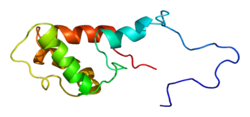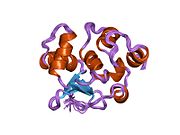ETS1
Protein C-ets-1 is a protein that in humans is encoded by the ETS1 gene.[5] The protein encoded by this gene belongs to the ETS family of transcription factors.[6]
Function
[edit]There are 28 ETS genes in humans and 27 in mice. They bind the DNA via their winged-helix-turn-helix DNA binding motif known as the Ets domain that specifically recognizes DNA sequences that contain a GGAA/T core element. However, Ets proteins differ significantly in their preference for the sequence flanking the GGAA/T core motif. For instance, the consensus sequence for Ets1 is PuCC/a-GGAA/T-GCPy. On the other hand, many natural Ets1-responsive GGAA/T elements differ from this consensus sequence. The later suggests that several other transcription factors may facilitate Ets1 binding to unfavorable DNA sequences. ChIP-Seq studies have shown that Ets1 can bind both AGGAAG and CGGAAG motifs.[7]
Ets1 binds to DNA as a monomer. Phosphorylation of serine residues of the C-terminal domain (in the nucleotide sequence they belong to exon VII) known as autoinhibition makes Ets1 inactive. There are several ways to activate Ets1. First, Ets1 can be dephosphorylated. Second, two Ets1 can be activated If two Ets molecules homodimerize. The homodimerization occurs if DNA binding sites are present in the correct orientation and spacing. Thus, the exact layout of binding sites within an enhancer or promoter segment to either relieve or allow autoinhibition of Ets1 to occur may strongly influence whether or not Ets1 actually binds to particular site. Third, Ets1 can be activated by Erk2 and Ras at Thr38. The truncated isoform cannot be phosphorylated by the Erk2. It is localized in the cytoplasm and acts as a dominant negative isoform. Contrary, another isoform that misses exon VII is constitutively active. Many Ras responsive genes harbor combinatorial Ets/AP1 recognition motifs through which Ets1 and AP1 synergistically activate transcription when stimulated by Ras.[8]
In adult humans, Ets1 is expressed at high levels mainly in immune tissues such as thymus, spleen, and lymph node (B cells, T cells, NK cells, and NK T cells and non-lymphoid immune cells). An enforced expression of Ets1 blocks differentiation of B- and T-cells. By contrast, knocking Ets1 down causes multiple defects in the immune system.
Knockout mice
[edit]Ets1 knockout mice have aberrant thymic differentiation, reduced peripheral T cell numbers, reduced IL-2 production, a skewing towards a memory/effector phenotype and impairments in the production of Th1 and Th2 cytokines. Although Ets1 knockout mice have an impaired development of Th1, Th2, and Treg cells, they have higher numbers of Th17 cells. In CD4/CD8 double positive thymocytes from Ets knockout mice, both the suppression of gene expression programs corresponding to alternative lineages and upregulation of T-cell specific genes are impaired.[7] There are also partial defects in bone marrow B cell development with reduced cellularity and inefficient transition from pro-B to pre-B cell stages.
Clinical significance
[edit]Meta-analyses of multiple genome-wide association studies has suggested an association of SNPs in the ETS1 locus with psoriasis in European populations. This is not surprising because Ets1 is a negative regulator of Th17 cells.
Ets1 overexpression in stratified squamous epithelial cells causes pro-oncogenic changes, such as suspension of terminal differentiation, high secretion of matrix metalloproteases (Mmps), epidermal growth factor ligands, and inflammatory mediators.
Interactions
[edit]Ets1 directly interacts with various transcription factors. Their interaction results in formation of multiprotein complexes. When Ets1 interacts with other transcription factors (Runx1, Pax5, TFE3, and USF1) its final effect on transcription depends on whether C-terminal domain is phosphorylated. Acetyltransferases CBP and p300 bind to the transactivation domain. AP1, STAT5 and VDR bind to C-terminal domain.
Also, ETS1 has been shown to interact with TTRAP,[9] UBE2I[10] and Death associated protein 6.[11]
Importantly, ETS1 was shown to be able to bind both nucleosome-bound and -depleted DNA, with its suppression leading to increases in nucleosomal occupancy at sites normally bound by ETS1. [7]
Interaction with DNA repair promoters and proteins
[edit]DNA repair promoters
[edit]The messenger RNA and protein levels of DNA repair protein PARP1 are controlled, in part, by the expression level of the ETS1 transcription factor which interacts with multiple ETS1 binding sites in the promoter region of PARP1.[12] The degree to which the ETS1 transcription factor can bind to its binding sites on the PARP1 promoter depends on the methylation status of the CpG islands in the ETS1 binding sites in the PARP1 promoter.[13] If these CpG islands in ETS1 binding sites of the PARP1 promoter are epigenetically hypomethylated, PARP1 is expressed at an elevated level.[13] The high constitutive levels of PARP1 in centenarians, providing more effective DNA repair, is thought to contribute to their unusual longevity. These levels of PARP1 expression are considered to be due to altered epigenetic control of transactivation of PARP1 expression.[14]
As shown by Wilson et al.,[15] increased ETS1 expression causes about 50 target genes to increase expression, including DNA repair genes MUTYH, BARD1, ERCC1 and XPA. Increased ETS1 expression causes resistance to cell killing by cisplatin, the resistance thought to be partly due to increased expression of DNA repair genes.
DNA repair protein interactions
[edit]ETS1 functions are regulated by protein – protein interactions.[16][17] In particular, ETS1 protein interacts with several DNA repair proteins. ETS1 binds with DNA-dependent protein kinase (DNA-PK) [where the DNA-PK complex is made up of DNA-PKcs and DNA repair Ku (protein), and where Ku itself is a heterodimer of two polypeptides, Ku70 (XRCC6) and Ku80 (XRCC5)].[17] ETS1 interaction with DNA-PK phosphorylates ETS1.[17] Such phosphorylation of ETS1 alters its target gene repertoire.[18] The Ku80 portion of DNA-PK, acting alone, interacts with ETS1 to down-regulate at least one of its transcriptional activities.[17]
As shown by Legrand et al.,[19] ETS1 protein interacts with PARP1 protein. ETS1 activates PARP1, causing poly ADP-ribosylation of PARP1 itself and of other proteins, even in the absence of nicked DNA. PARP1 (without self- poly ADP-ribosylation), in turn, is needed for activation of the transactivating activity of ETS1 on a tested promoter. Active PARP1 subsequently causes poly ADP-ribosylation of ETS1, and this appears to promote ETS1 ubiquitination and proteasomal degradation, preventing excessive activity of ETS1.
References
[edit]- ^ a b c GRCh38: Ensembl release 89: ENSG00000134954 – Ensembl, May 2017
- ^ a b c GRCm38: Ensembl release 89: ENSMUSG00000032035 – Ensembl, May 2017
- ^ "Human PubMed Reference:". National Center for Biotechnology Information, U.S. National Library of Medicine.
- ^ "Mouse PubMed Reference:". National Center for Biotechnology Information, U.S. National Library of Medicine.
- ^ Delattre O, Zucman J, Plougastel B, Desmaze C, Melot T, Peter M, Kovar H, Joubert I, de Jong P, Rouleau G (Sep 1992). "Gene fusion with an ETS DNA-binding domain caused by chromosome translocation in human tumours". Nature. 359 (6391): 162–5. Bibcode:1992Natur.359..162D. doi:10.1038/359162a0. PMID 1522903. S2CID 4331584.
- ^ Dwyer J, Li H, Xu D, Liu JP (Oct 2007). "Transcriptional regulation of telomerase activity: roles of the Ets transcription factor family". Annals of the New York Academy of Sciences. 1114 (1): 36–47. Bibcode:2007NYASA1114...36D. doi:10.1196/annals.1396.022. PMID 17986575. S2CID 44532648.
- ^ a b c Cauchy P, MA, Zacarias-Cabeza J, Vanhille L (2016-05-05). "Dynamic recruitment of Ets1 to both nucleosome-occupied and -depleted enhancer regions mediates a transcriptional program switch during early T-cell differentiation". Nucleic Acids Research. 44 (8): 3567–85. doi:10.1093/nar/gkv1475. ISSN 0305-1048. PMC 4856961. PMID 26673693.
- ^ Wasylyk B, Hagman J, Gutierrez-Hartmann A (1998). "Ets transcription factors: nuclear effectors of the Ras-MAP-kinase signaling pathway". Trends Biochem. Sci. 23 (6): 213–6. doi:10.1016/S0968-0004(98)01211-0. PMID 9644975.
- ^ Pei H, Yordy JS, Leng Q, Zhao Q, Watson DK, Li R (May 2003). "EAPII interacts with ETS1 and modulates its transcriptional function". Oncogene. 22 (18): 2699–709. doi:10.1038/sj.onc.1206374. PMID 12743594. S2CID 35966215.
- ^ Hahn SL, Wasylyk B, Criqui-Filipe P, Criqui P (Sep 1997). "Modulation of ETS-1 transcriptional activity by huUBC9, a ubiquitin-conjugating enzyme". Oncogene. 15 (12): 1489–95. doi:10.1038/sj.onc.1201301. PMID 9333025. S2CID 26170389.
- ^ Li R, Pei H, Watson DK, Papas TS (Feb 2000). "EAP1/Daxx interacts with ETS1 and represses transcriptional activation of ETS1 target genes". Oncogene. 19 (6): 745–53. doi:10.1038/sj.onc.1203385. PMID 10698492. S2CID 22299529.
- ^ Soldatenkov VA, Albor A, Patel BK, Dreszer R, Dritschilo A, Notario V (1999). "Regulation of the human poly(ADP-ribose) polymerase promoter by the ETS transcription factor". Oncogene. 18 (27): 3954–62. doi:10.1038/sj.onc.1202778. PMID 10435618. S2CID 43548938.
- ^ a b Bi FF, Li D, Yang Q (2013). "Hypomethylation of ETS transcription factor binding sites and upregulation of PARP1 expression in endometrial cancer". Biomed Res Int. 2013: 946268. doi:10.1155/2013/946268. PMC 3666359. PMID 23762867.
- ^ Chevanne M, Calia C, Zampieri M, Cecchinelli B, Caldini R, Monti D, Bucci L, Franceschi C, Caiafa P (2007). "Oxidative DNA damage repair and parp 1 and parp 2 expression in Epstein-Barr virus-immortalized B lymphocyte cells from young subjects, old subjects, and centenarians". Rejuvenation Res. 10 (2): 191–204. doi:10.1089/rej.2006.0514. PMID 17518695.
- ^ Wilson LA, Yamamoto H, Singh G (2004). "Role of the transcription factor Ets-1 in cisplatin resistance". Mol. Cancer Ther. 3 (7): 823–32. doi:10.1158/1535-7163.823.3.7. PMID 15252143. S2CID 27514847.
- ^ Li R, Pei H, Watson DK (2000). "Regulation of Ets function by protein - protein interactions". Oncogene. 19 (55): 6514–23. doi:10.1038/sj.onc.1204035. PMID 11175367.
- ^ a b c d Choul-li S, Drobecq H, Aumercier M (2009). "DNA-dependent protein kinase is a novel interaction partner for Ets-1 isoforms". Biochem. Biophys. Res. Commun. 390 (3): 839–44. doi:10.1016/j.bbrc.2009.10.059. PMID 19836356.
- ^ Shiina M, Hamada K, Inoue-Bungo T, Shimamura M, Uchiyama A, Baba S, Sato K, Yamamoto M, Ogata K (2015). "A novel allosteric mechanism on protein-DNA interactions underlying the phosphorylation-dependent regulation of Ets1 target gene expressions". J. Mol. Biol. 427 (8): 1655–69. doi:10.1016/j.jmb.2014.07.020. PMID 25083921.
- ^ Legrand AJ, Choul-Li S, Spriet C, Idziorek T, Vicogne D, Drobecq H, Dantzer F, Villeret V, Aumercier M (2013). "The level of Ets-1 protein is regulated by poly(ADP-ribose) polymerase-1 (PARP-1) in cancer cells to prevent DNA damage". PLOS ONE. 8 (2): e55883. Bibcode:2013PLoSO...855883L. doi:10.1371/journal.pone.0055883. PMC 3566071. PMID 23405229.
Further reading
[edit]- Reddy ES, Rao VN (1988). "Structure, expression and alternative splicing of the human c-ets-1 proto-oncogene". Oncogene Research. 3 (3): 239–46. PMID 3060801.
- Lincoln DW, Bove K (Jan 2005). "The transcription factor Ets-1 in breast cancer". Frontiers in Bioscience. 10 (1–3): 506–11. doi:10.2741/1546. PMID 15574387.
External links
[edit]- ETS1+protein,+human at the U.S. National Library of Medicine Medical Subject Headings (MeSH)
- Drosophila pointed - The Interactive Fly
- FactorBook ETS1
This article incorporates text from the United States National Library of Medicine, which is in the public domain.
















